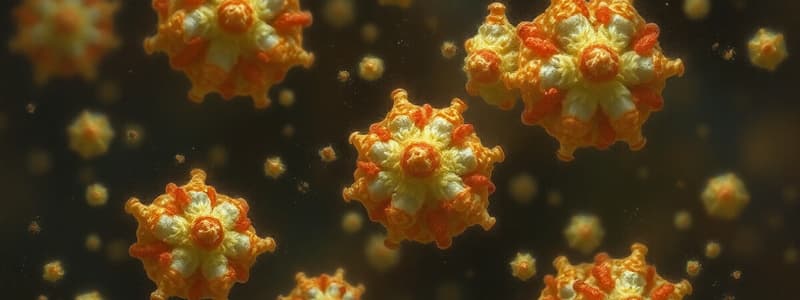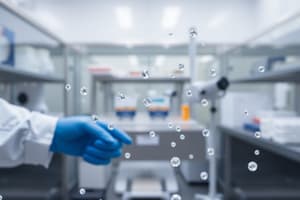Podcast
Questions and Answers
Which product type had the lowest total percentage of contamination?
Which product type had the lowest total percentage of contamination?
- Oily
- Spirits (correct)
- Gels
- Dry
Which type of contaminant was found to have the highest number of isolates?
Which type of contaminant was found to have the highest number of isolates?
- Staphylococcus aureus
- Pseudomonas aeruginosa (correct)
- Escherichia coli
- Salmonella spp.
What is the maximum allowable level of aerobic bacteria in products for oral administration without specific conditions?
What is the maximum allowable level of aerobic bacteria in products for oral administration without specific conditions?
- <10³
- <10⁴ (correct)
- <10⁵
- <10²
What type of contamination occurs during the manufacture of a product?
What type of contamination occurs during the manufacture of a product?
Which contaminant is specified as absent in sterile preparations according to BP standards?
Which contaminant is specified as absent in sterile preparations according to BP standards?
What is the contamination limit for fungi in products of natural origin that are for oral administration?
What is the contamination limit for fungi in products of natural origin that are for oral administration?
Which of the following is correctly paired with its preparation requirements according to BP standards?
Which of the following is correctly paired with its preparation requirements according to BP standards?
What type of microorganisms are classified as obligate intracellular parasites?
What type of microorganisms are classified as obligate intracellular parasites?
Which of the following is NOT a common consequence of microbial contamination in pharmaceuticals?
Which of the following is NOT a common consequence of microbial contamination in pharmaceuticals?
Which microorganism is primarily the focus of pharmaceutical microbiology due to its potential to cause significant contamination?
Which microorganism is primarily the focus of pharmaceutical microbiology due to its potential to cause significant contamination?
Which of the following statements accurately describes the Gram-negative cell wall?
Which of the following statements accurately describes the Gram-negative cell wall?
Which potential infective agent is linked to causing bacterial meningitis?
Which potential infective agent is linked to causing bacterial meningitis?
What is a shared characteristic of both fungi and protozoa?
What is a shared characteristic of both fungi and protozoa?
Which of these historical figures contributed significantly to the understanding of germ-related diseases?
Which of these historical figures contributed significantly to the understanding of germ-related diseases?
Which microbe is typically associated with otitis media infections?
Which microbe is typically associated with otitis media infections?
What is a potential health hazard to patients from microbial contamination of pharmaceutical products?
What is a potential health hazard to patients from microbial contamination of pharmaceutical products?
Which of the following is NOT a consequence of microbial contamination in pharmaceutical preparations?
Which of the following is NOT a consequence of microbial contamination in pharmaceutical preparations?
Which statement about endotoxins is correct?
Which statement about endotoxins is correct?
What factors are important for the quality control of pharmaceutical products?
What factors are important for the quality control of pharmaceutical products?
Which type of pharmaceutical product requires specific manufacturing conditions due to its sterile nature?
Which type of pharmaceutical product requires specific manufacturing conditions due to its sterile nature?
In which of the following scenarios is microbial contamination most critical?
In which of the following scenarios is microbial contamination most critical?
What is the primary concern regarding manufacturing sites that are not registered with regulatory authorities?
What is the primary concern regarding manufacturing sites that are not registered with regulatory authorities?
Which organism was reported in the contamination of Serum vaccine in 1948?
Which organism was reported in the contamination of Serum vaccine in 1948?
What characterizes the change in appearance of pharmaceutical products due to microbial contamination?
What characterizes the change in appearance of pharmaceutical products due to microbial contamination?
Which of the following is a type of toxin associated with microbial contamination?
Which of the following is a type of toxin associated with microbial contamination?
Which bacteria is known for extreme antibiotic resistance, particularly in cystic fibrosis patients?
Which bacteria is known for extreme antibiotic resistance, particularly in cystic fibrosis patients?
What percentage of total non-sterile product recalls by the FDA was attributed to Gram-negative bacteria?
What percentage of total non-sterile product recalls by the FDA was attributed to Gram-negative bacteria?
Which bacteria is commonly isolated as a microbial contaminant in various environments, especially associated with biofilm formation?
Which bacteria is commonly isolated as a microbial contaminant in various environments, especially associated with biofilm formation?
What is the maximum contamination level found in some examined samples, expressed in organisms per gram or mL?
What is the maximum contamination level found in some examined samples, expressed in organisms per gram or mL?
Which of the following bacteria was historically classified under Pseudomonas?
Which of the following bacteria was historically classified under Pseudomonas?
During the Public Health Laboratory Service investigation, what proportion of examined samples showed detectable contamination?
During the Public Health Laboratory Service investigation, what proportion of examined samples showed detectable contamination?
What type of antimicrobial resistance is commonly associated with Pseudomonas aeruginosa?
What type of antimicrobial resistance is commonly associated with Pseudomonas aeruginosa?
Which bacterium is not typically associated with pneumonia?
Which bacterium is not typically associated with pneumonia?
Which of the following is a major contributing factor for product recalls related to microbial contamination?
Which of the following is a major contributing factor for product recalls related to microbial contamination?
Which method is commonly employed to assess the microbial diversity in pharmaceuticals?
Which method is commonly employed to assess the microbial diversity in pharmaceuticals?
Which bacteria are NOT commonly linked to skin infections?
Which bacteria are NOT commonly linked to skin infections?
What underlying factor makes Burkholderia cepacia a concern for cystic fibrosis patients?
What underlying factor makes Burkholderia cepacia a concern for cystic fibrosis patients?
What is true about pyrogens?
What is true about pyrogens?
What statement is accurate regarding the fungal meningitis outbreak?
What statement is accurate regarding the fungal meningitis outbreak?
Which bacteria are commonly associated with urinary tract infections?
Which bacteria are commonly associated with urinary tract infections?
What is the consequence of microbial contamination linked to the meningitis outbreak?
What is the consequence of microbial contamination linked to the meningitis outbreak?
Which organism is a causative agent of gastritis?
Which organism is a causative agent of gastritis?
Which of the following is not typically involved in food poisoning?
Which of the following is not typically involved in food poisoning?
Which sexually transmitted disease agent is correctly paired?
Which sexually transmitted disease agent is correctly paired?
Which is NOT a characteristic of a pyrogen?
Which is NOT a characteristic of a pyrogen?
Flashcards
Microbial contamination
Microbial contamination
A condition where microorganisms contaminate a medicinal product, potentially impacting its safety and effectiveness.
Consequences of microbial contamination
Consequences of microbial contamination
Microbial contamination can result in infections and diseases, like bacterial meningitis or otitis media, posing a significant risk to patients' health.
Common microbial contaminants
Common microbial contaminants
Common culprits include bacteria, fungi, and viruses, each posing specific risks to pharmaceutical products.
Sources of contamination
Sources of contamination
Signup and view all the flashcards
Gram-positive and Gram-negative bacteria
Gram-positive and Gram-negative bacteria
Signup and view all the flashcards
Bacterial meningitis
Bacterial meningitis
Signup and view all the flashcards
Otitis media
Otitis media
Signup and view all the flashcards
What is a pyrogen?
What is a pyrogen?
Signup and view all the flashcards
What are Enterobacteriaceae?
What are Enterobacteriaceae?
Signup and view all the flashcards
What is Campylobacter jejuni?
What is Campylobacter jejuni?
Signup and view all the flashcards
What is Helicobacter pylori?
What is Helicobacter pylori?
Signup and view all the flashcards
What is Staphylococcus aureus?
What is Staphylococcus aureus?
Signup and view all the flashcards
What is Escherichia coli (E. coli)?
What is Escherichia coli (E. coli)?
Signup and view all the flashcards
What is Staphylococcus saprophyticus?
What is Staphylococcus saprophyticus?
Signup and view all the flashcards
What is Pseudomonas aeruginosa?
What is Pseudomonas aeruginosa?
Signup and view all the flashcards
What is Streptococcus pyogenes?
What is Streptococcus pyogenes?
Signup and view all the flashcards
What is Clostridium?
What is Clostridium?
Signup and view all the flashcards
Endotoxin
Endotoxin
Signup and view all the flashcards
Product degradation
Product degradation
Signup and view all the flashcards
Toxin production
Toxin production
Signup and view all the flashcards
Patient infection
Patient infection
Signup and view all the flashcards
Route of administration
Route of administration
Signup and view all the flashcards
Registered manufacturing site
Registered manufacturing site
Signup and view all the flashcards
Quality control
Quality control
Signup and view all the flashcards
Sterile product manufacturing
Sterile product manufacturing
Signup and view all the flashcards
Reported microbial contamination
Reported microbial contamination
Signup and view all the flashcards
Water availability and contamination
Water availability and contamination
Signup and view all the flashcards
Contamination rate vs. formulation type
Contamination rate vs. formulation type
Signup and view all the flashcards
Common bacterial contaminant
Common bacterial contaminant
Signup and view all the flashcards
BP standards for microbial contamination
BP standards for microbial contamination
Signup and view all the flashcards
Contamination limits for topical and oral products
Contamination limits for topical and oral products
Signup and view all the flashcards
Sterility requirements in pharmaceutical products
Sterility requirements in pharmaceutical products
Signup and view all the flashcards
Pseudomonas aeruginosa
Pseudomonas aeruginosa
Signup and view all the flashcards
Burkholderia cepacia
Burkholderia cepacia
Signup and view all the flashcards
Chlorhexidine-cetrimide
Chlorhexidine-cetrimide
Signup and view all the flashcards
Coliform bacteria
Coliform bacteria
Signup and view all the flashcards
Clostridium tetani
Clostridium tetani
Signup and view all the flashcards
Staphylococcus aureus
Staphylococcus aureus
Signup and view all the flashcards
Gram-negatives
Gram-negatives
Signup and view all the flashcards
Ralstonia picketti
Ralstonia picketti
Signup and view all the flashcards
Yeasts & molds
Yeasts & molds
Signup and view all the flashcards
Study Notes
Microbial Contamination
- Microbial contamination is a broad term encompassing various microorganisms that can cause disease and spoil products, including pharmaceuticals and medical products.
Learning Objectives
- The objectives cover what microbial contamination is, its consequences in medical products, common contaminants in pharmaceuticals, and sources of contamination.
A Bit of History
- 1831: Latta introduced intravenous therapy for cholera patients.
- 1847: Semmelweis discovered hand disinfection drastically reduced puerperal fever incidence.
- 1860: Pasteur's experiments linked germs to disease.
- 1880-1910: Koch founded modern bacteriology.
Types of Microorganisms
- Microorganisms like fungi, yeasts, protozoa, viruses, and bacteria can contaminate products.
- Eukaryotes: Free-living or parasitic; often facultative, not obligate parasites,
- Viruses: Obligate intracellular parasites; 20-300 nm; core of nucleic acid surrounded by a protein shell (capsid).
- Bacteria: Prokaryotic cells; primary focus in pharmaceutical microbiology, categorized by Gram-positive and Gram-negative cell walls based on their structures.
Dangers of Contamination
- Microbial contamination can lead to various health problems in patients, such as bacterial meningitis, pneumonia, eye infections, skin infections, and more.
- Pyrogens: Substances causing fever, either internally or externally to the body (e.g., endotoxins).
- Endotoxins: Molecules associated with Gram-negative bacteria recognized by the immune system, even when the bacteria are dead or fragmented.
Consequences of Contamination
- Product Degradation: Spoilage of active ingredients or excipients, altering appearance and smell.
- Toxin Production: Endotoxins from Gram-negative bacteria, tetanus toxin, and enteric toxins can be harmful.
- Infection: Contaminated products can cause wounds, bacteraemia and often death in severe cases.
Contamination Frequency
- Non-sterile product recalls often involve B. cepacia, P. aeruginosa, or Ralstonia picketti. These account for 48% of recalls.
- Yeasts and molds account for 23%. Sterile products have lower contamination rates, with gram-negative bacteria being implicated more often.
- B. cepacia is the most commonly isolated contaminant.
Public Health Investigation
- About 27% of samples examined contained contamination.
- Contamination levels ranged from less than 10 to 105-106 organisms per milliliter or gram.
- Contamination rates were similar across product types, and there was a correlation between high contamination and water content of the products.
- Most contaminants were gram-positive bacilli or micrococci, which are often not pathogenic. Yeast and molds were also common findings, particularly in creams and ointments.
BP Standards - Microbiological Quality (Sterility Tests)
- Different preparation categories (sterile, topical, oral, etc.) have varying standards for microorganisms.
- The standards focus on absence or low counts of aerobic bacteria and fungi.
Sources of Contamination
- Environmental: Airborne particles, contaminated diluents, syringes, lines, applicators (sponges), and equipment are common sources.
- Human: Personnel, hair, skin, cosmetics, clothing, and administration techniques contribute.
- Product: Contamination can arise during manufacture.
- Post-manufacture: Products can also become contaminated during administration, particularly in situations utilizing multi-use vials.
- Patients: Patients' skin flora, mucous membranes, and saliva are sources of contamination.
- Contamination often depends on factors like water content in products.
Studying That Suits You
Use AI to generate personalized quizzes and flashcards to suit your learning preferences.




